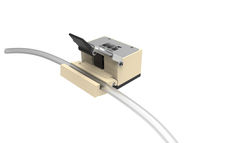Nanotechnology boosts war on superbugs
Advertisement
Nature nanotechnology journal reveals how scientists from the London Centre for Nanotechnology (LCN) at UCL are using a novel nanomechanical approach to investigate the workings of vancomycin, one of the few antibiotics that can be used to combat increasingly resistant infections such as MRSA. The researchers, led by Dr Rachel McKendry and Professor Gabriel Aeppli, developed ultra-sensitive probes capable of providing new insight into how antibiotics work, paving the way for the development of more effective new drugs.
During the study Dr McKendry, Joseph Ndieyira, Moyu Watari and coworkers used cantilever arrays – tiny levers no wider than a human hair – to examine the process which ordinarily takes place in the body when vancomycin binds itself to the surface of the bacteria. They coated the cantilever array with mucopeptides from bacterial cell walls and found that as the antibiotic attaches itself, it generates a surface stress on the bacteria which can be detected by a tiny bending of the levers. The team suggests that this stress contributes to the disruption of the cell walls and the breakdown of the bacteria.
The interdisciplinary team went on to compare how vancomycin interacts with both non-resistant and resistant strains of bacteria. The 'superbugs' are resistant to antibiotics because of a simple mutation which deletes a single hydrogen bond from the structure of their cell walls. This small change makes it approximately 1,000 times harder for the antibiotic to attach itself to the bug, leaving it much less able to disrupt the cells' structure, and therefore therapeutically ineffective.
"The cell wall of these bugs is weakened by the antibiotic, ultimately killing the bacteria," said Dr McKendry. "Our research on cantilever sensors suggests that the cell wall is disrupted by a combination of local antibiotic-mucopeptide binding and the spatial mechanical connectivity of these events. Investigating both these binding and mechanical influences on the cells' structure could lead to the development of more powerful and effective antibiotics in future."
Most read news
Topics
Organizations
Other news from the department science
These products might interest you

Hose pressure transducer by HiTec Zang
Contactless pressure measurement for sterile applications
Easy-to-install tubing pressure sensors for diameters from 4.8-19.1 mm

FireSting-PRO by PyroScience
New fiber optic measuring device: Precise measurements even in the smallest volumes
Measure pH, oxygen and temperature even under sterile conditions

Get the life science industry in your inbox
By submitting this form you agree that LUMITOS AG will send you the newsletter(s) selected above by email. Your data will not be passed on to third parties. Your data will be stored and processed in accordance with our data protection regulations. LUMITOS may contact you by email for the purpose of advertising or market and opinion surveys. You can revoke your consent at any time without giving reasons to LUMITOS AG, Ernst-Augustin-Str. 2, 12489 Berlin, Germany or by e-mail at revoke@lumitos.com with effect for the future. In addition, each email contains a link to unsubscribe from the corresponding newsletter.


























































